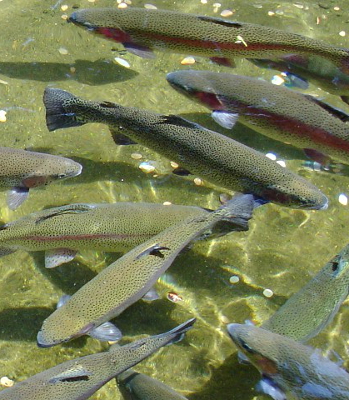
Stocking an earthen pond
 Tim Matson didn't
provide much information on pond biology because he was trying to
keep the plants in his pond to a minimum. However, he did
include a list of flora in his section on wildlife ponds,
mentioning that fish, ducks, and geese will all eat Sago pondweed,
wild celery, coontail, elodea, muskgrass (gives fish an off
flavor), arrowhead, wild Japanese millet, wild rice (needs flowing
water), lotus, waterlilies, iris, pickerel plant, burr reed,
cattails, smartweed, and bulrush.
Tim Matson didn't
provide much information on pond biology because he was trying to
keep the plants in his pond to a minimum. However, he did
include a list of flora in his section on wildlife ponds,
mentioning that fish, ducks, and geese will all eat Sago pondweed,
wild celery, coontail, elodea, muskgrass (gives fish an off
flavor), arrowhead, wild Japanese millet, wild rice (needs flowing
water), lotus, waterlilies, iris, pickerel plant, burr reed,
cattails, smartweed, and bulrush.
Fish were more
Matson's cup of tea, specifically trout. As with the paucity
of information on plant life, Matson didn't try to cover the needs
of different kinds of fish, but he did warn new pond owners away
from dropping fish into their water right away. It often
takes about a year for water quality to stabilize in an earthen
pond, with initially low pH and low-dissolved-oxygen levels slowly
being mitigated by an influx of organic matter and by the growth
of microorganisms. Short of buying water-testing equipment,
the best way to know if your pond is ready for fish is to drop a
few cheap ones in and see if they survive.
I hope you've enjoyed
these tidbits from Earth
Ponds, even
though the information is more suited to half-acre-and-larger
ponds than to little backyard water gardens. As you can
tell, I've been doing
experiments of my own about how to make an earth pond that
better fits the backyard, and I'll continue to keep you
posted about the results.
| This
post is part of our Earth
Ponds lunchtime series.
Read all of the entries: |
Want more in-depth information? Browse through our books.
Or explore more posts by date or by subject.
About us: Anna Hess and Mark Hamilton spent over a decade living self-sufficiently in the mountains of Virginia before moving north to start over from scratch in the foothills of Ohio. They've experimented with permaculture, no-till gardening, trailersteading, home-based microbusinesses and much more, writing about their adventures in both blogs and books.
Want to be notified when new comments are posted on this page? Click on the RSS button after you add a comment to subscribe to the comment feed, or simply check the box beside "email replies to me" while writing your comment.
